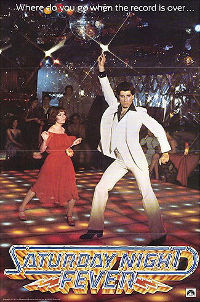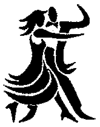|
|
Hustle, One Of Our Less Common Rhythms
by Harold & Meredith Sears
 Hustle had its roots in New York
City in the early 1970s. It is said that in the '60s the Twist all
but destroyed ballroom dancing. No longer did the dancer need to
learn steps or even have a partner. The Twist ushered in the frug,
swim, monkey, jerk, mashed potato, hand jive, madison, stroll,
locomotion, freak — just as many quirky creations as we had had
animal dances 50 years before (squirrel, snake hip, grizzly bear,
duck waddle, chicken scratch, bunny hug, and more), only now we
didn't touch. "Do your own [individual] thing" was the
style of the day. Then the Hustle came along, and partner dancing was
back. Van McCoy wrote Do the Hustle in 1975. The movie
Saturday Night Fever came out in '77. In Europe, a similar
rhythm developed called Discofox. Dancers could touch. These rhythms
were hugely popular. Hustle had its roots in New York
City in the early 1970s. It is said that in the '60s the Twist all
but destroyed ballroom dancing. No longer did the dancer need to
learn steps or even have a partner. The Twist ushered in the frug,
swim, monkey, jerk, mashed potato, hand jive, madison, stroll,
locomotion, freak — just as many quirky creations as we had had
animal dances 50 years before (squirrel, snake hip, grizzly bear,
duck waddle, chicken scratch, bunny hug, and more), only now we
didn't touch. "Do your own [individual] thing" was the
style of the day. Then the Hustle came along, and partner dancing was
back. Van McCoy wrote Do the Hustle in 1975. The movie
Saturday Night Fever came out in '77. In Europe, a similar
rhythm developed called Discofox. Dancers could touch. These rhythms
were hugely popular.
Hustle was surprisingly quickly introduced into Round Dancing,
but
it has yet to really "take hold"—
- Hustle-A-Round, a 3- & 4-count Hustle by the
Wards, 1978
- Cinderella-Rockefella, a 4-count "Disco-Jive" by the
Easterdays, 1987
- Be My Lover, a 3- & 4-count Hustle by the
Shibatas, 2001
- You Owe Me One, a 4-count Hustle (also Cha) by the
Worlocks, 2005
- Night Fever, a 3-count Discofox by the Schmidts, 2005
- Self Control, a 3-count Discofox by the Schmidts,
2006
- Dancing Queen, a 3-count Discofox by Müller/Sroka,
2006
- Dancin' Disco, a 3-count "Hustle or Discofox" by the
Woodruffs, 2006
- The Tide Is High, a 3-count Discofox by Müller/Haas,
2007
- Street Life, a 3-count Discofox by the Schmidts, 2009
The word "hustle" makes this
dance rhythm sound a lot faster and more frantic than it really is.
Hustle is related to swing, and the music is a pounding disco, but
the tempo is slow. The official American tempo is 28-30
measures/minute — closer to West Coast Swing than to Jive. Hustle
is light, smooth, and flat, a soft gliding back and forth in the
slot, an elastic stretching apart and together,with the man moving
gracefully out of the woman's way, or a gentle turning on a spot.
There are a lot of changes of directions and turns and spins by both
the woman and the man. She especially may come to feel like a yo-yo,
but a smooth and flowing yo-yo, not a jerky, bouncy one. Jive is
"hot," but Hustle is "cool."
Hustle figures mostly consist of
four
steps. We can do them on the beat, and four-count Hustle is danced
1234. The same figures can be danced, with syncopation, in only three
beats of music, and three-count hustle is danced &123 in Be My
Lover or 12&3 in more recent dances. Actually, the
syncopation in three-count Hustle could be danced anywhere in the
measure (e.g., 1&23 or 123&).
You might ask, how do we dance
three-count figures to 4/4 music? The answer is that each three-count
figure takes less than a measure. A sequence of three-count Hustle
could be danced like this: (&/1,2,3,) (&/4;1,2,) (&/3,4;1,)
(&/2,3,4;) — four figures over three measures of music. This
works because Hustle has a very regular, disco beat with no very
prominent downbeat on count 1. You can feel pretty comfortable
starting a figure on beat 1, 2, 3, or 4.
A perhaps picky note on timing:
The
standard for the use of the "&" in timing is to place
it after the count that is being split or syncopated. With
this standard, in cha, in swing, in the syncopated foxtrot chasse,
and elsewhere, we can know for sure which are the quicker, half-beat
steps and which are the full-beat steps. In a 123&4 measure, we
know that the steps on 1, 2, and 4 are full-count, and the steps on 3
and & are half-count each. Without the standard, in this measure,
we have to worry, or at least consider, that the choreographer might
intend us to step fully on 1, 2, and 3, and to split the 4-count:
&/4. Now, if you look at the punctuation that I have used above,
you can see that hustle choreographers sometimes do not adhere to the
standard usage of the &-count. In reading cue sheets, it seems
that there are two reasons for non-standard usage.
-
The syncopated beat in hustle
is a ball/change, so it is tempting, for unity or clarity, to package
those two steps together as an "&/3," even though what we are
really dancing is 1, 2/&, 3 (splitting the 2-ct, not the 3-ct).
-
Especially if we are beginning our figures with the
ball/change, it simplifies the cue sheet to write it &/1, 2, 3,
even though what we are really dancing is /&; 1, 2, 3 [splitting
the 4-ct of the previous measure for the "ball" and dancing the
"change" on the 1-ct of this measure as a full-count step].
On the other hand, in your own dancing, you will feel the
music
and dance to the music, and whether the fine print on the cue sheet
says 1, 2/&, 3, or 1, 2, &/3, won't matter at all.
A Few Figures ---
Hustle has not been standardized
by
Roundalab. These descriptions are taken from the cue sheets for the
dances listed above, and the timing given is that used by the
choreographer. But remember, any figure could be danced with
different syncopation or with the even, four-count timing.
Basic 12&3
In a low
butterfly position, rock forward left (W fwd R), and recover on the
trail feet. This is an elastic rock together and apart. Then place
the ball of the left foot back with partial weight and recover (W bk
R/rec L) [ball/change].
Left Turning Basic 12&3
In butterfly position rock forward
left
(W fwd R) turning 1/4 left-face, back right (W bk L) trng 1/4
left-face and narrowing the butterfly. Then place the ball of the
left foot back with partial weight and recover (W bk R/rec L)
[ball/change].
Right Turning Basic 12&3
In butterfly position rock forward
left
(W fwd R) turning 1/4 right-face, back right (W bk L) trng 1/4
right-face and narrowing the butterfly. Then place the ball of the
left foot back with partial weight and recover (W bk R/rec L)
[ball/change].
For instance, in Dancin' Disco
by the Woodruffs, the dance begins with a Basic twice ; ,,
Left-Turning Basic twice , ;; Basic twice ; ,, Right-Turning Basic
twice , ;;
Push Break &123
Facing partner in a low butterfly
position, rock apart on the lead feet with a small step and recover
on the trail feet. This is a little ball/change, apart and together.
Then both check forward a small step on the lead feet, hands out to
sides a bit, and step back on the trail feet, pushing into partner.
The Push Break feels the same as the Basic but with the ball/change
first instead of last.
Close &123
In low butterfly facing line of
dance,
rock back on the lead foot a small step, and cross the right in front
of the left, turning right-face 1/4. The woman rocks back right and
steps forward left. Step side left, and she steps forward right and
turns 1/2 right-face. Finally, close right to left (W steps back L).
End in an L-shaped, closed position, man facing wall, woman facing
line. Of course, the figure can be done from other facing directions.
Release &123
In the L-shaped, closed position,
man
facing wall and woman facing line, lead hands joined, trail arms in
closed position, the man steps side left and recovers, releasing his
right hand. The woman rocks back right and steps forward left,
turning left face. This has a slingshot feel to it. He crosses left
in front of right, turns left face 1/4 to face line, and steps back
She continues turning, steps side and back right, and steps back left
to face reverse. We end in butterfly line. The Release is always done
from the Hustle L-shaped, closed position, but your facing direction
may vary. Second, you may release to other ending positions than
butterfly, such as left open position or left open facing position.
A nice, basic sequence is Push
Break
twice ; ,, Close and Release twice , ;;; ,, and repeat , ;;;;;
Travolta 1234
In a facing position, no hands
joined,
point the left foot to the side (W points R). The knee is turned
inward. The left hip is up. The right hand is at the right hip, and
the left arm is across the body with the index finger pointed down to
the right (woman mirrors man throughout). Look in the direction of
the pointed finger. All of this is to set up the Travolta action.
On beat 1, use a circular hip
rotation
to pop your right hip out and turn the left foot (W R foot) to a
press line. bring the left arm straight up to the left with pointed
index finger, and look in the direction of the pointed finger. On
beat 2, bring the lead arm down to the right side (woman left side)
with lead foot and head following the motion. On beat 3, bring lead
arm up again with the lead foot and head following the motion. On
beat 4, bring the lead arm back down to the right side again with
foot and head following the motion. You are pointing up to the left,
then down to the right, and repeating. There is no change of weight
during the figure.
In Night Fever by the
Schmidts,
part C begins with a syncopated vine to the Travolta;; roll 3 ball
change; reverse roll 3 ball change; repeat;;;;
A
version of this
article was
published in the Washington Area Square Dancers Cooperative Association
(WASCA) Calls 'n' Cues, January, 2011; and in the DRDC Newsletter, March 2012.

If you would like to read other articles on dance
position, technique, styling, and specific dance rhythms, you may visit
the article TOC.
Past DRDC Educational Articles archived here.
Go beyond this site. Find other references on our Sources and Links
pages.
|

